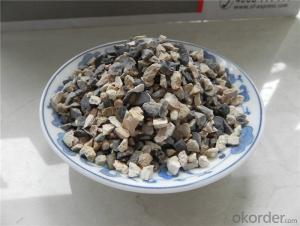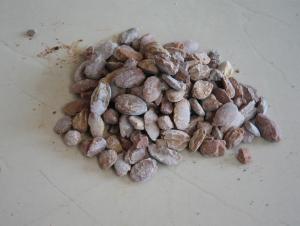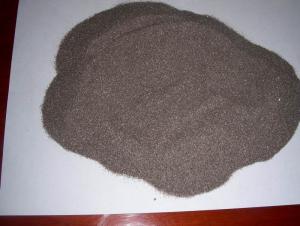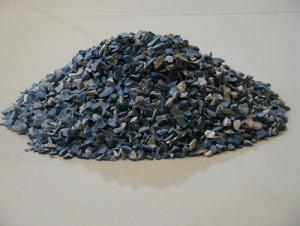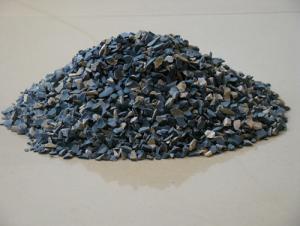Bauxite Ore / Raw Bauxite / High Alumina Bauxite
- Loading Port:
- China main port
- Payment Terms:
- TT OR LC
- Min Order Qty:
- 25 m.t.
- Supply Capability:
- 10000 m.t./month
OKorder Service Pledge
OKorder Financial Service
You Might Also Like
Quick Details
| Shape: | Fines (Powder) | Dimensions: | 0-1mm,1-3mm, 3-5mm, 5-8mm100#, 180#, 200#, 300# | Chemical Composition: | Al2O3 CaO Fe2O3 |
| Concentrate Or Not: | Non-concentrate | Moisture (%): | 0.03% Max | Al2O3 (Min): | 50%-85% |
| Place of Origin: | Henan, China (Mainland) | Brand Name: | CNBM | Model Number: | B-1 |
| Product name: | Bauxite | Color: | Brown Yellow or Light Red | Mohs Hardness: | 1~3 |
| Thermal Conductivity: | 0.03℃ | Refractory temperature: | 1790℃ | Density: | 3.45g/cm3 |
| Compressive strength: | 55Mpa | Package: | 50kg/bag | Customization: | Accept |
| Sample: | Sample Provided |
Packaging & Delivery
| Packaging Details: | 50kg/polywoven bag or as customers requirements |
| Delivery Detail: | 7 days |
Product Introduction
Refractory Material Bauxite Clinker for All Kinds of Particle Size
Bauxite, also known as alumina, the main component is alumina, which is hydrated alumina containing impurities, a kind of earthy mineral. White or gray, because containing iron it will brown yellow or light red. Density is 3.45g / cm3, hardness is 1-3, opaque, brittle. Extremely difficult to melt. Insoluble in water, soluble in sulfuric acid and sodium hydroxide solution. Mainly used for aluminum smelting, manufacture refractories.
Product Application
Refractory Material Bauxite
1. aluminum industry. For defense, aerospace, automotive, electrical, chemical, and other daily necessities.
2. casting. Bauxite is processed into a fine powder made after the mold casting. Used in military, aerospace, communications, instrumentation, machinery and medical equipment sectors.
3. used for refractory products. High bauxite refractoriness up to 1780 ℃, chemical stability, good physical properties.
4. aluminosilicate refractory fibers. Light weight, high temperature, good thermal stability, low thermal conductivity, heat capacity of small and resistance to mechanical vibration and so on. For iron and steel, nonferrous metallurgy, electronics, petroleum, chemical, aerospace, nuclear, defense and other industries. It is the high alumina clinker into the melting temperature of about 2000 ~ 2200 ℃ high temperature electric arc furnace, high temperature melting, high pressure high velocity air or steam injection, cooling, it becomes white "cotton" - aluminum silicate refractory fibers. It can be pressed into fiber blanket, plates, or woven into fabric instead of smelting, chemical, glass and other industrial high-temperature furnace lining of refractory bricks. Firefighters available refractory fiber cloth to make clothes.
5. with magnesia and bauxite as raw material, adding an appropriate binder for casting ladle whole bucket liner very good results.
6. manufacture of cement, abrasive materials, ceramic industry as well as various compounds chemical industry can be made of aluminum bauxite.
Product Parameters
Item | Specification | Item | Specification |
Color | Brown Yellow or Light Red | Thermal Conductivity | 0.03℃ |
Density | 3.45g/cm3 | Refractory temperature | 1790℃ |
Mohs Hardness | 1~3 | Compressive strength | 55Mpa |
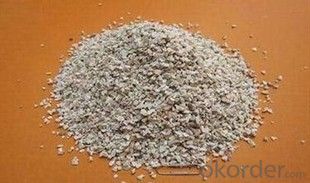
- Q:How to distinguish the fire resistant level of the rubber and plastic thermal insulation material?
- It is divided into level A, B1, B2 and B3. According to the current "burning behavior of building materials classification method", Level A insulation material is a non-combustible material, which belongs to YT. However, from the point of view of the current market , level A insulation material are very few, only glass wool, rock wool board, foam glass and vitrified micro bead. However, compared with level A insulation material, the more welcomed by the market is the organic insulation material. This is characterized as thermal insulation material, which is divided into three levels: level B1 is flame retardant, level B2 is flammable and level B3 is flammable. The level B1 nonflammable thermal insulation material is determined according to the fire endurance of the material. And different parts of the material are divided differently! Such as the common EPS / XPS insulation boards through special treatment of adding flame retardant. . Level B2 combustible insulation material is commonly the EPS expanded polystyrene foam insulation board and XPS board, that is, the ordinary plate. This material has low ignition point, and releases large amounts of harmful gases in the combustion process . Level B3 flammable insulation material is commonly the thermal insulation material taking polystyrene foam as the main material. Since this material is highly flammable, it has been out of the external wall thermal insulation materials. As for the civil construction insulation materials, China's current popular building insulation materials in the market are mainly made of three organic foams: EPS (molded polystyrene board), XPS (extruded polystyrene board) and PU (polyurethane).
- Q:How to choose construction external wall thermal insulation and fireproofing materials?
- The width of fireproof partition shuld be greater than 30CM, and the thickness should be the same as total thickness of thermal insulation materials. Fire barrier zone thermal insulation board and base wall should be stuck in whole area. Fire Barrier zone thermal insulation board should be stuck with the assistance of anchor bolt which must press the mesh of the bottom layer. Fire Barrier zone should be set above the door and window, with a distance of less than 50cm between the lower edge of fire barrier zone and the upper edge of window.
- Q:Does the production of refractory belong to advanced technology?
- It certainly is advanced technology as it is the new material.
- Q:Who can introduce the difference between galvanized fireproof?coatings and steel structure fireproof materials?
- When the steel surface derusted, it generally needs to brush rich-zinc primer before spraying fireproof coating. Fireproof coating plan itself includes anticorrosion plan, and fireproof coating is just a layer of coating plans, which is an intermediate layer in general. Fireproof coating plan generally includes primer, fireproof coating and finishing paint. Some fireproof coatings can be directly painted on the bare steel elements without primer and finishing paint. Galvanized surface generally is not necessarily needed for brushing fireproof coating. Fireproof and galvanized surface have relatively poor bond strength, so it is advisable to brush transitional lacquer or micaceous iron on the galvanized surface.
- Q:Which kind of external wall fire barrier zone material is better?
- The following types are: rock wool, aerated concrete, phenolic aldehyde and foam cement rock wool fire barrier zone "rock wool board" mainly uses water-repelling rock wool board produced by pendulum method as thermal insulation layer materia, and connecting and fixing base wall by binding and nail bonding, it is composed level A non-combustible building energy efficiency thermal insulation system by plastering layer composed by plastering mortar and glass?fiber mesh and decorative mortar finishing layer or coating. Good air permeability
- Q:For refractory, why is it necessary to store the first mixing materials for some time under proper moisture and temperature?
- It is mainly to remove gas form chemical reactions in the pug, give full play to plasticity and binding properties of combined, and store unburned?brick whose cememting agent is phosphoric?acid or aluminium?phosphate for some time under proper moisture and temperature. For example, to avoid the formed bricks in the initial stage of drying and firing form cracking due to hydration of calcium oxide. Mixing materials is to store the first mixing materials for some time under proper moisture and temperature in order to improve the evenness and moldability of pud, such as making the distribution of combined clay and water more even. The length of storing chiefly depends on the process requirements and the characteristics of blanks. For the producing pug of high temperature kiln furnitures, the storing time is longer. The function of storing mxing materials varies with different natures of blanks. For honeycomb ceramics, it is to fully digest calcium oxide in blanks. For storing magnesia brick blanks containing much calcium oxide, it should be stored for some time in proper humidity and temperature.
- Q:Which schools are the best schools in the world for learning knowledge about refractories?
- If you search on a worldwide scale, I might say you are ambitious!!! This major becomes an unpopular one and you must have to embark on graduate and PhD to specialize in it provided that you want to go abroad for further study. Wuhan University of Science and Technology may be the best school in this field with its close relatinship with many refractory manufacture factories across the country. Henan University of Science and Technology is also advisable in terms of this major, which probably promise you a job. Other universities in this regard are not quite familiar to me. You raised these questions, which shows that you are a layman to this major or not quite familiar with this major. If you have any questions, you can resort to me if I can.
- Q:I am a refractory material manufacturer, sold products, money is always not back, anxious to die, what is the way?
- Looking for refractory materials network, you can conduct online transactions, funds guaranteed
- Q:What are the requirements of the performances of brasque refractory?
- Physical properties of refractories include structural property, thermal property, mechanical property, usability and operation property. Structural properties of refractories include porosity, bulk density, water absorption, air permeability, pore size distribution,etc.. Refractory thermal properties include thermal conductivity, thermal expansion coefficient, specific heat, heat capacity, thermal diffusivity, thermal emissivity. Mechanical properties of refractories include compression strength, tensile strength, breaking strength, torsional strength, shear strength, impact strength, abrasion resistance, creep property, bonding strength, elasticity modulus. usabilities of refractories include refractoriness, refractoriness under load, reheating linear change, thermal shock resistance, slag resistance, acid resistance, alkali resistance, water resistance, corrosion resistance to CO, conductivity, oxidation resistance, etc.. Operation properties of refractory include consistence, slump, fluidity, plasticity, cohesiveness, resilience, coagulability and hardenability,etc. I hope you can solve the problem with my answer.
1. Manufacturer Overview |
|
|---|---|
| Location | |
| Year Established | |
| Annual Output Value | |
| Main Markets | |
| Company Certifications | |
2. Manufacturer Certificates |
|
|---|---|
| a) Certification Name | |
| Range | |
| Reference | |
| Validity Period | |
3. Manufacturer Capability |
|
|---|---|
| a)Trade Capacity | |
| Nearest Port | |
| Export Percentage | |
| No.of Employees in Trade Department | |
| Language Spoken: | |
| b)Factory Information | |
| Factory Size: | |
| No. of Production Lines | |
| Contract Manufacturing | |
| Product Price Range | |
Send your message to us
Bauxite Ore / Raw Bauxite / High Alumina Bauxite
- Loading Port:
- China main port
- Payment Terms:
- TT OR LC
- Min Order Qty:
- 25 m.t.
- Supply Capability:
- 10000 m.t./month
OKorder Service Pledge
OKorder Financial Service
Similar products
New products
Hot products
Related keywords

